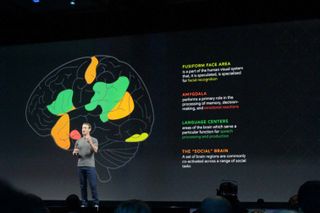Facebook Shows New Social Presence Demo, Oculus Reveals Avatars, Parties, Rooms
To kick off this year’s Oculus Connect, Facebook CEO Mark Zuckerberg talked about the fusion of virtual reality and social interaction. In addition to Zuckerberg’s short demo, Oculus also unveiled a plethora of social-based software for its VR platforms.

An Update On Facebook And VR
At Facebook’s annual F8 Developer’s Conference this year, the company showed off an early prototype of how it would use VR as a way for friends to hang out, interact with objects and explore new places. The avatars that represented each person were just mannequin heads and hands (although you could add some details to your face with a few colored pencils). Six months later, the development team made some major improvements to the feature.
Instead of the barebones head and hands, each avatar is now fully represented above the waist so you’ll see a body, hands, arms, legs and the head. Facial features are also more accurate and don’t look as if you just drew them with colored pencils; the mouth even moves when you talk. To make it more realistic, you can also display specific facial gestures such as a smile, a surprised look or even laughter.
At F8, the demo showed that you could “travel” to other places, a.k.a. 360-degree images. However, this new demo also showed that you could transport your group to another location with the help of 360-degree videos. In order to transport the group to other worlds, each avatar wears a watch. When you press the watch, it displays a series of images and videos. All you have to do is pick an image and the world around you changes to the desired location. In addition to admiring the view, you can also start a game with friends with a virtual deck of cards or a chessboard. At one point, Zuckerberg even had a sword while his other friend in the demo drew his own sword with a colored pencil. If games aren’t your thing, you can also watch videos with your friends in VR.









You can even chat with other friends who don’t have a VR device. Zuckerberg’s wife, Priscilla Chan, called him via the Messenger app. She was able to see the avatars, as well as the world around them, even though she wasn’t using the Rift.
The foundation for this social interaction demo was Oculus’ Toybox demo where two people played with an assortment of toys in a virtual space. From there, the developers at Facebook made upgrades to the environment, the avatars, and most importantly, the interactions. The upgraded avatars, as well as the new facial expressions, are part of the company’s plan to integrate face and eye tracking into VR, which provides an additional layer of immersion. It took a mere six months to make those improvements, and the updated demo is yet another taste of what the company has in store for the future of social interaction.
Avatars And Parties For The Rift
Oculus had some surprises for Rift owners in store as well. In a similar vein to Facebook’s work, the company introduced its own Avatars program, so that you can have a digital representation of yourself throughout the platform. There’s also a development kit available so that studios can integrate each person’s avatar in their own games. With the Oculus Touch controllers, you can customize your avatar’s face, clothes, hairstyle, and accessories. According to Oculus, the amount of custom parts for your avatar means that there are about one billion combinations available.
Stay on the Cutting Edge
Join the experts who read Tom's Hardware for the inside track on enthusiast PC tech news — and have for over 25 years. We'll send breaking news and in-depth reviews of CPUs, GPUs, AI, maker hardware and more straight to your inbox.

With the new Avatars, you can create a Party with up to eight people so that you can hang out with your friends and set up a voice call. If you want to have more fun, you can try out the new Oculus Rooms. You can watch videos, listen to music and play mini-games with your friends. The group can even join another social-based app together, and developers can easily add party support to their apps with the company’s API.
Coming Soon
Oculus plans to release its Avatar and Rooms program in the next few months. If you own a Rift, you can make your own Avatar when the Oculus Touch is released in December, and it will make its way to the Gear VR in “early 2017.” As for the Parties and Rooms, it will arrive first to the Gear VR in a few weeks. Those on the Rift will have to wait until early next year to try out Parties and Rooms.
-
VUTURUS Hey Zuck; Your Paper #Avatar Sucks Virtual Ass, just like your #RealName Policy!Reply
We don't want #NSA Rooms We want Virtual Worlds where #PrivacyMatters!
Take your Paper Dolls and #Advertising Riddled VR Ambitions and place them where
the Virtual Sun doesn't shine! #VR NOT Interested! -
pindiespace It's worth pointing out that the WebVR protocol that the Carmel browser will use is already in development builds of Google Chrome, Mozilla Firefox, and (soon) Microsoft Edge. Individuals and brands have been creating Web-based VR for almost 2 years, and there's a library that lets older (mobile) browsers simulate WebVR. So, you don't have to wait for Oculus, you can begin working with WebVR right now! It will be interesting to see exactly what Oculus does with their own browser. To get a handle on the current action in WebVR, check the Slack channel - https://webvr-slack.herokuapp.com.Reply
Most Popular



